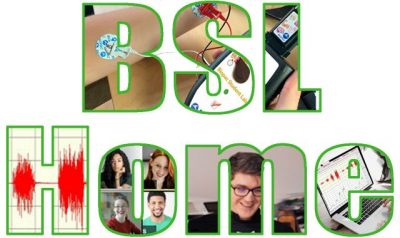BSL Home Lessons

BSL Home Lessons for Single-channel Data Recorder
BSL Home guides students to record great life science data from their own bodies— heart signals (ECG), brain waves (EEG), muscle activity (EMG), eye movement (EOG), and Respiration.
Student-friendly, media-rich software provides prompts, screen shots, and lesson videos to demonstrate calibration, setup & cable management, recording procedures, and data comparison.
Tutorial-style guided lessons and active learning segments for student-designed experiments.
Experimental Objectives
L01 Electromyography (EMG) I — Standard & Integrated EMG
Students investigate the properties of skeletal muscle by measuring maximum clench strength.
L02 Electromyography (EMG) II — Motor Unit Recruitment & Fatigue
Students lift weights to examine motor unit recruitment and skeletal muscle fatigue.
L03 Electroencephalography (EEG) I —Relaxation & Brain Rhythms
Introduces students to electroencephalography by recording from the occipital lobe.
L04 Electroencephalography (EEG) II — Alpha Rhythms in the Occipital Lobe
Students discover how the brain constantly receives and integrates sensory input.
L05 Electrocardiography (ECG) I — Components of the ECG
Introduces students to electrocardiography and the recording of the heart’s electrical signals. Bipolar Leads, Einthoven’s Law, Mean Electrical Axis on the Frontal Plane. Explains Einthoven’s triangle while students perform tasks designed to change the rhythm of the heart.
L08 Respiratory Cycle I — Respiratory Rates, Relative Depths of Breathing, Regulation of Ventilation
Students observe and record EMGs from thoracic respiratory skeletal muscle during eupnea and voluntary apnea.
L10 Electrooculogram (EOG) I — Eye Movement; Saccades & Fixation
Students record horizontal eye movements during real and simulated tracking of a pendulum.
L14 Biofeedback —Relaxation & Arousal
Explores the concept of biofeedback training and its effect on autonomic control of heart rate.
L15 Aerobic Exercise Physiology — Cardiovascular & Respiratory Adjustments During and After Exercise
Students record ECG and HR to see how the electrical activity of the heart and heart rate change.
Tasks Performed by the Student
L01 Electromyography (EMG) I
L02 Electromyography (EMG) II
L03 Electroencephalography (EEG) I
L04 Electroencephalography (EEG) II
L05 Electrocardiography (ECG) I
|
L08 Respiratory Cycle I
L10 Electrooculogram (EOG) I
L14 Biofeedback
L15 Aerobic Exercise Physiology
|
Videos
BSL Home | Biopac Student Lab for In Lab, Hybrid, or Remote Use
BSL Home L01 Cal
BSL Home L01 Recording
BSL Home L02 Recording
BSL Home L02 Cal
BSL Home L02 Recording - Fatigue
BSL Home L03 Recording
BSL Home L03 Recording Seg 3
BSL Home L03 Recording Segment 4
BSL Home L06 Recording
BSL Home L08 Recording Seg 1
BSL Home L08 Recording Segment 2
BSL Home L08 Recording Segment 3
BSL Home L10 Calibration
BSL Home L10 Pendulum
BSL Home L10 Recording 1B
BSL Home L10 Recording 2
BSL Home L10 Recording Segment 1
BSL Home L15 Recording
How to Start a BSL Home Lesson Recording
BSL Home Installation
Student Prep & Distance Learning
Click the link(s) below for sample data and/or lesson procedure video(s), BSL PRO Lesson procedures (PDF) for human lessons*, and graph template files (*.gtl) for BSL PRO Lessons. If more than one .gtl is available, download the .gtl with the _suffix to match BSL version and hardware.
Lesson Hardware
Choose a Practical Lab Kit to purchase (BSL-HOME-B) or, if available in your area, to lease through the "Learn & Return" program (BSL-HOME).
The BSL Home Accessory Pack is optional for purchased systems and not needed for leased systems; it includes all the consumables students need to run all nine BSL Home Lessons. School bookstores or libraries can purchase BSL Home Accessory Packs and manage distribution to students.
| Item | Name | Cart |
|---|---|---|
| BSL-HOME-B | Practical Lab Kit with BSL 4 & MP41 | Add to Cart |
| BSL-HOME | Practical Lab Kit for Remote Learning | Add to Cart |
| BSL-HOME-ACC1 | BSL Home Accessory Pack | Add to Cart |

Stay Connected